Chaparral 2F: Jim Hall's winged wonder
Using wings to create downforce had been attempted in the ’50s but, as Doug Nye explains, it was Jim Hall’s advanced Chaparral 2F from 1967 that proved the idea. Motor racing was never the same again
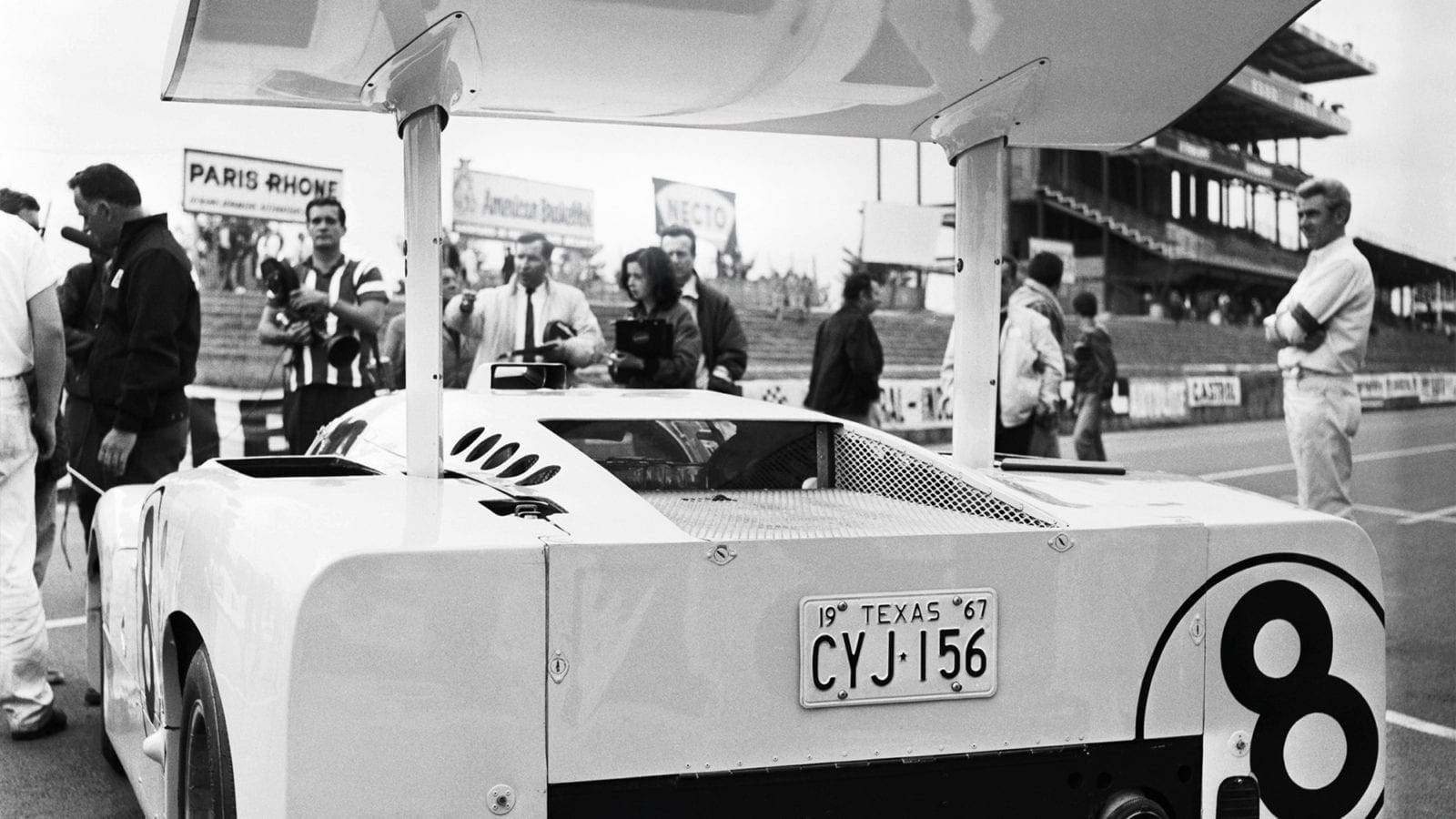
Car had movable rear wing, operated by driver
Corbis/VCG via Getty Images
Don’t doubt it for one moment: Jim Hall of Chaparral Cars in Midland, Texas is a towering figure in motor racing history. During 1966-67 he proved influential
in racing car design, backed clandestinely by General Motors R&D, even if it was not particularly successful in keeping that secret.
When I first compiled a target list of cars to be invited to the inaugural Goodwood Festival of Speed in 1993, Chaparrals were near the top. It took 10 years or so before the Texan accepted, but he and his cars have returned several times and always receive a rapturous reception from the knowledgeable audience.
While the first Chaparral rolled off the production line in 1961, built by Dick Troutman and Tom Barnes, it wasn’t until 1962 that Hall and Hap Sharp launched Chaparral Cars Inc. They then set to work on the Chaparral 2 that won the United States Road Racing Championship in 1964 and began its domination of the US road-racing scene, including a Sebring 12 Hours win in 1965. It was the perfect platform for what came next.
“We went faster and faster around the corners”
While assorted pioneers had previously fitted aerodynamic aids to racing cars, it was Hall’s Chaparral-Chevrolet Can-Am and World Championship of Makes designs that changed the face of racing. Hall would recall how he realised that the key was to “make [aerodynamic] forces work for you so that applied downforce improved traction”.
He admitted he didn’t initially realise how far others had previously explored that field, while allowing that in 1961-62 Ferrari had tried a ducktail spoiler developed with its American test driver Richie Ginther: “I happened to ride to Sebring with him from the airport and I asked him about their tail spoiler. ‘Well,’ he said, ‘it just stabilises the car, and it keeps the exhaust fumes out of the cockpit.’”
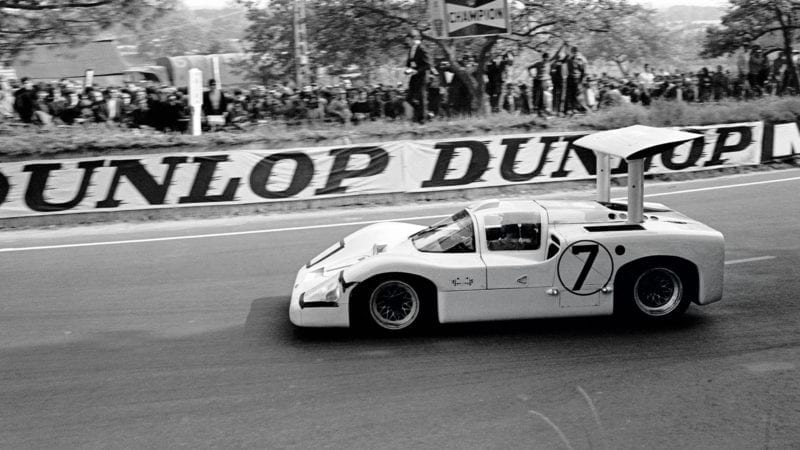
After three hours in the pits at the Le Mans 24 Hours in 1967 the Chaparral 2F retired, but the team’s have-a-go attitude was admired by the crowd
Klemantaski Collection/Getty Images
Back at base, Hall toyed with his early rear- engined Chaparral’s body shape. A neutral-lift design proved “terrible” and prone to oversteer at higher speeds, so further changes came. The solution, Hall thought, was to “load them down, so they don’t become oversteerers. They stay neutral and then you balance the car out over a big speed range, so it handles the way you want it, neutral or a little bit of understeer, throughout the whole speed range.
“We started with a little flip-up on the back until we got it neutral. Then we started putting more and more downforce on it, and finally we went faster and faster around the corners. But the straightaway speed was then so slow you couldn’t pass anybody.
“The 2F looked beautiful with a long, sloping rear screen”
“So then we put the flipper on, then we cured the nose-dive, then we put on the high suspension-mounted wing. We didn’t start going to 4000lb springs like [later] Formula 1 cars. We were on 400lb springs, so we took the load off the suspension springs and put it directly onto the hub, and that’s where the high wings came from.
“The whole thing is putting downforce on the car to improve traction capabilities, without increasing weight by the same amount.”
Back in 1956, Swiss engineer Michael May had reached a somewhat similar conclusion and arrived at the Nürburgring 1000Kms with his Porsche 550 Spyder sporting a tall strutted wing. After practice, the German scrutineers cheerfully told him that everyone had enjoyed the joke; “Now take it off.” So he did.
In 1965 Hall had allies in GM R&D. Larry Shinoda recalled a pyramid wing mount, spreading load front and rear. Colleague Paul van Valkenburgh experimented with a wooden wing on a Corvette, before his colleague Joe Kurleto formed lighter wing sections from foam-filled aluminium sheet.
Chaparral’s first test wing at Midland had been a sheet of 3⁄4-inch plywood. Mechanic Troy Rogers fitted it on one of their glassfibre-tub 2A cars. Team chiefs and drivers Hall and Sharp told him to drive it before they took the risk. Despite a strong wind ripping across their Rattlesnake Raceway test track, Rogers blasted around some laps and “couldn’t believe how it stuck to the ground. I came in and said, ‘You’ve got something here!’”
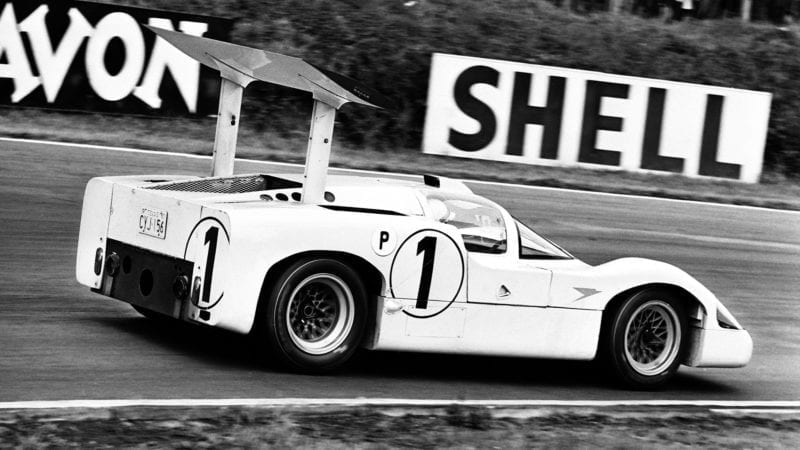
The twisty Brands Hatch circuit played to the 2F’s strengths at the BOAC 500 in 1967
The Chaparral 2E Can-Am cars had more than just a tall wing high above the rear wheels. Their radiators were moved from a nose mounting to a midship position. This freed the nose and its top-ducted airway to be reprofiled to act as a venturi, accelerating airflow and generating downforce to balance the strutted wing’s rear-end effect.
A flap in the intake was connected to a third pedal in the automatic-transmission car’s previously two-pedal cockpit. The rear wing’s at-rest position was leading-edge low/ trailing-edge high to generate downforce. Up front, the duct flap would then be open with airflow generating a balancing downforce upon the front end. When the driver hit the third pedal, the rear wing would flip into a neutral attack angle to minimise drag while the nose-duct flap would shut, reducing front-end downforce and drag from the flap.
Air otherwise trapped within the front wheel arches escaped via louvred relief panels, matched on the rear-deck engine cover and tail transom panel.
Hall and Phil Hill drove these jaw-dropping new 2Es in the 1966 Can-Am series, starting at Bridgehampton, Long Island, with wing collapses occurring on both cars during a fraught practice period. A radius rod provided the lateral location for the tall twin struts, and a rod-end had snapped. The rod on Hall’s car was reinforced, re-installed at a different angle, and Hill drove it in the race, finishing fourth after the wing actuation system failed, leaving the new wing flipped up into the fail-safe downforce position.
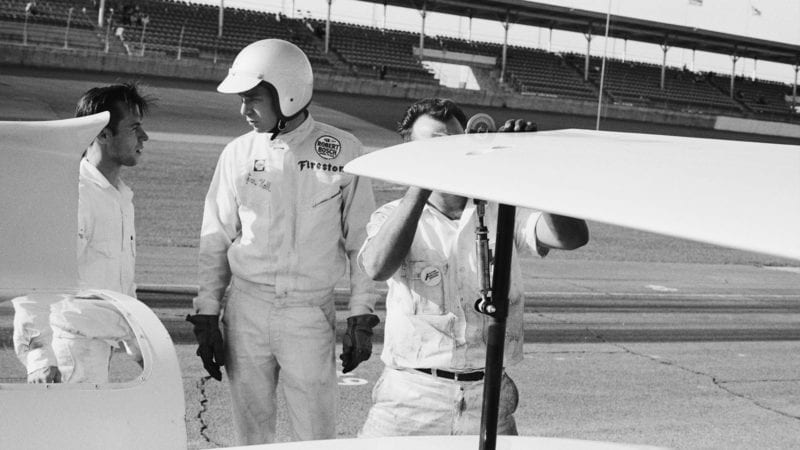
Jim Hall — creative engineer, team chief, driver
Hill then finished second in the 2E at Mosport Park before he won at Laguna Seca with Hall second – a winged Chaparral one- two triumph. They were leading the Can-Am Championship, but at Riverside Hill’s car overheated and suffered fuel vapourisation. Hall took the lead from John Surtees’ Lola T70, and then also suffered fuel vapourisation under the desert sun, finishing second.
The Can-Am title was to be decided at Stardust Raceway in Las Vegas and the Chaparrals qualified one-two on the front row. Hill said, “There was no way we were going to stay there because the 2E would go off the startline like a ’41 Dodge Fluid Drive. I mean they were just dead because of that darned automatic gearbox.”
At the first turn Hill’s car was rammed, and its right-front fender shattered. After seven laps, Hall’s wing actuation rod then snapped, leaving the wing fluttering, and Hill’s failed similarly. But the title contender felt an obligation to continue. The inoperative wing was removed at a pitstop, and the struts linked instead by a spacer bar, producing “the most diabolical handling car”. Hill limped home seventh and Surtees emerged as the inaugural Can-Am champion.
In December, Sharp drove one of the 2Es in the Bahamas Speed Week at Nassau, but on the last lap crashed into some trackside trees and destroyed the lightweight chassis.
But Sharp and Hall were launching an ambitious assault upon the 1967 World Championship of Makes. At Midland, a new Chaparral-Chevrolet 2F coupé was being built to use an aluminium 7-litre big-block ‘Porcupine’ V8 engine with three-speed auto transmission and 2E-style nose venturi with tall strutted rear wing systems. Extraordinarily, the 2F did not use the surviving lightweight aluminium 2E for the new year’s updated 2G Can-Am car. Instead, the 2F used one of the team’s first three glass- fibre monocoques from 1963-64.
With the strutted wing mounted on the rear suspension uprights to exert downforce directly to the wheels and tyres and the nose venturi and flap system up front, the 2F’s radiators were hip-mounted, as on the 2E. The shorter pipe runs minimised overall coolant capacity, and thereby weight, while the cockpit could be cooler than the preceding ‘FIA’ Chaparral 2D coupés. Rearward weight bias was increased while, relieved of warm radiator air passing over the cabin roof, cold air could feed the carburettors without the 2D-type roof-top intake. Roof-shape, windscreen and door glazing were taken straight from the 2D design, but the body sides were flat-topped and slab-sided. Innovative use was made of aerospace – or surfboard-style – glassfibre sandwich mouldings, and Hall saved weight by using two small aircraft batteries, one behind each seat. Can-Am 2E-style 16in wheels housed 12in diameter disc brakes. Where the 2D coupé had used bolt-on wheels, the 2F was much more orientated towards endurance racing and pit stops, with centre-lock triple- Heared knock-off attachments.
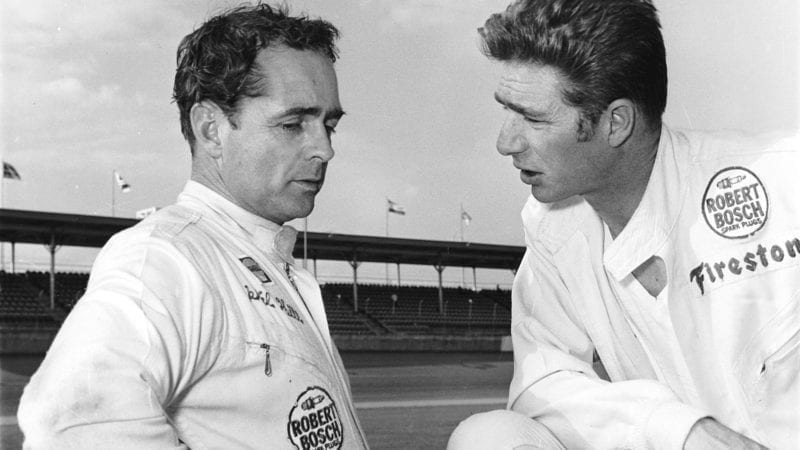
Hill and Hall at Daytona, 1967, where Chaparral debuted its 2F
Hill was teamed with the English driver Mike Spence – ex-Lotus, now of BRM – for Chaparral’s 1967 World Championship of Makes campaign. That February Chaparral entered two cars for the first round, the Daytona 24 Hours: Hill/Spence in the winged 2F, Bob Johnson/Bruce Jennings in the year-old 2D. For the Florida banking the 2F was fitted with double spring/damper units on each wheel. The wing struts were unfaired, the wing locked into the downforce position and the nose-duct trapdoor inoperative. The 2F looked beautiful with a long, sloping rear screen.
Facing six 7-litre Ford GT40 MkIIs, two Ferrari 330 P4s and a 330 P3/4, Hill moved into an early lead. But after Spence’s first stint, Hill took over for his second and found the track surface breaking up where the infield road circuit section re-joined the banking. Phil slid straight up into the wall. The prototype 2F was too badly damaged to continue.
For the following Sebring 12 Hours the 2F appeared with its operating wing system, a vertical rear window and roof buttresses extending down each side to a flat rear deck. But Hill had appendicitis so could not race. Hall instead joined Spence, who blazed through the field after the white coupé refused to start at flag fall. He regained 40 places in two hectic laps and eventually took the lead when the new Ford GT MkIVs and Mk IIBs began their pit stops. As dusk fell, the 2F’s auto gearbox failed, and the 2D had already retired. It was later converted into a second 2F.
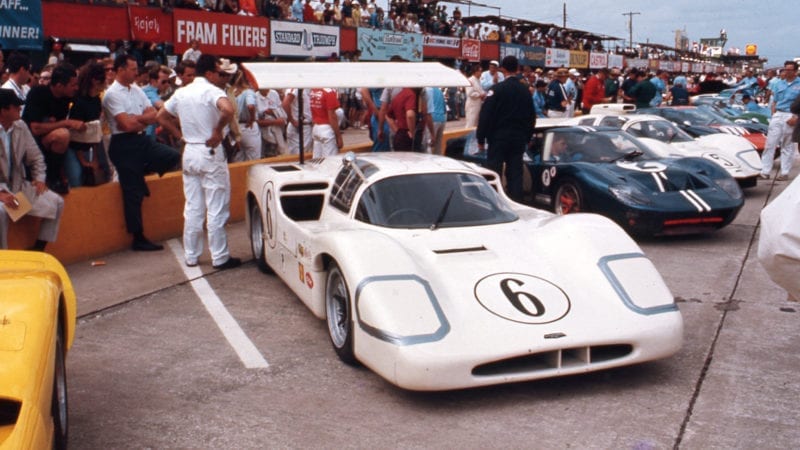
With Phil Hill taken ill in practice at the 1967
Sebring 12 Hours, chief
Jim Hall stepped in to partner Mike Spence in the 2F
The Chaparral team then moved to Europe, basing itself in the GM Opel plant at Rüsselsheim, as they had with the 2D the previous year. For the Monza 1000Kms on April 25, the recovered Hill and Spence drove 2F-002. They started from pole, but within the first hour Spence had a driveshaft coupling fail – the race was over.
Five days later, at the Spa 1000Kms, Hill and Spence shared 2F-001, subtly modified with a small trim tab on the trailing edge of the tall rear wing enabling it to feather at speeds above 140mph on the fast circuit, while a horizontal splitter was attached to the nose’s bottom edge. Race day dawned to pouring rain. The 2F competed with its rear wing in downforce position. Spence set the fastest lap but the car was delayed in the pits by battery trouble, before the auto transmission failed, again.
Sharp fulfilled an ambition to experience the Targa Florio in Sicily. The 44-mile course was unsuitable for the Chaparral 2F-001, but on May 14, 1967, Sharp and Hill competed regardless. Hill finished the first lap fifth and Sharp later inherited fourth, before a puncture nine laps in ended their spectacular run, to tremendous sympathy from the crowd.
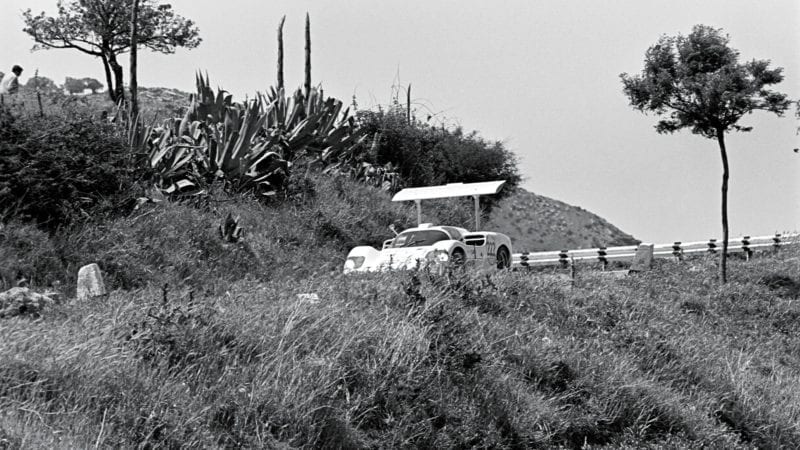
2F was quick on Targa Florio before suffering a puncture
In May came the ADAC 1000Kms at the Nürburgring, where Hill and Jo Bonnier had won in the 2D the previous year. Hill qualified fastest but started tardily since Hall insisted that he pause to fasten his seatbelts during the Le Mans-style start. Starting 11th, he took second place behind Jo Siffert’s works Porsche four laps later. The veteran American set the fastest lap and took Siffert for the lead on the ninth lap.
But one lap later, the 2F’s transmission began rumbling. Spence took over, but another transmission failure ended their race.
For Le Mans, 2F-001 was co-driven by Jennings/Johnson, 2F-002 by Hill/Spence. The wing struts were now faired. After typically slow starts, Spence led when the leading Fords began their pitstops. Third after his stop, Spence had the wing actuation fail, the download position robbing speed on the straights. The second car retired with familiar battery and start troubles.
Just after 5am Phil brought the surviving 2F in from third place, only for a fluid leak from the gearbox to be spotted. Hall was determined to finish. The resulting work cost three agonising hours. Spence re-joined the race… and the gearbox failed terminally.
After Le Mans 2F-002 was returned to Texas while 2F-001 was prepared at Rüsselsheim for the final title-deciding BOAC 500 race at Brands Hatch. The car’s auto transmission fragility had at last been addressed. It had been overwhelmed by the immense power and torque of the 7-litre engine, as against the preceding 2D’s 5.7-litre. Redesigned mainshafts and seals had taken time to acquire, but now they were fitted, and Hill/ Spence qualified on the outside of the front grid row. Spence ran third among the Ferrari P4s, Lola T70s, Porsches and Gulf-Mirages.
He led before a puncture dropped the 2F back to third. Hill took over and staged an electrifying charge. He hacked back 2sec per lap, urged on by the pro-Chaparral British crowd. He took the lead and brought the ‘plastic fantastic’ home to its first race win – and his last, in what proved to be the great American world champion’s final front-line drive.
Years later, Hall declared, “I enjoyed the 2F, quite a nice car. It was fun to compete against Ford at that time. It was a David and Goliath deal. I believe that the 2F was a better car than the Ford Mark IV, a faster race car. Had the transmission not been a problem we would have won a lot of those races. The engine was good by that time and the chassis were durable. We could have continued another year.”
The FIA, alarmed by escalating speed and power of those 7-litre endurance race projectiles, would introduce the 5-litre sports and 3-litre prototype capacity rules for 1968, and the Chaparral 2F’s brief flare was extinguished. For enthusiasts, however, it remains magical.
Signalled by its huge strutted wing, the Chaparral 2F proved that downforce could be manipulated and exploited radically to increase traction and grip. Although Jim Hall’s major innovation would soon be banned, it pointed the way ahead for racing car design
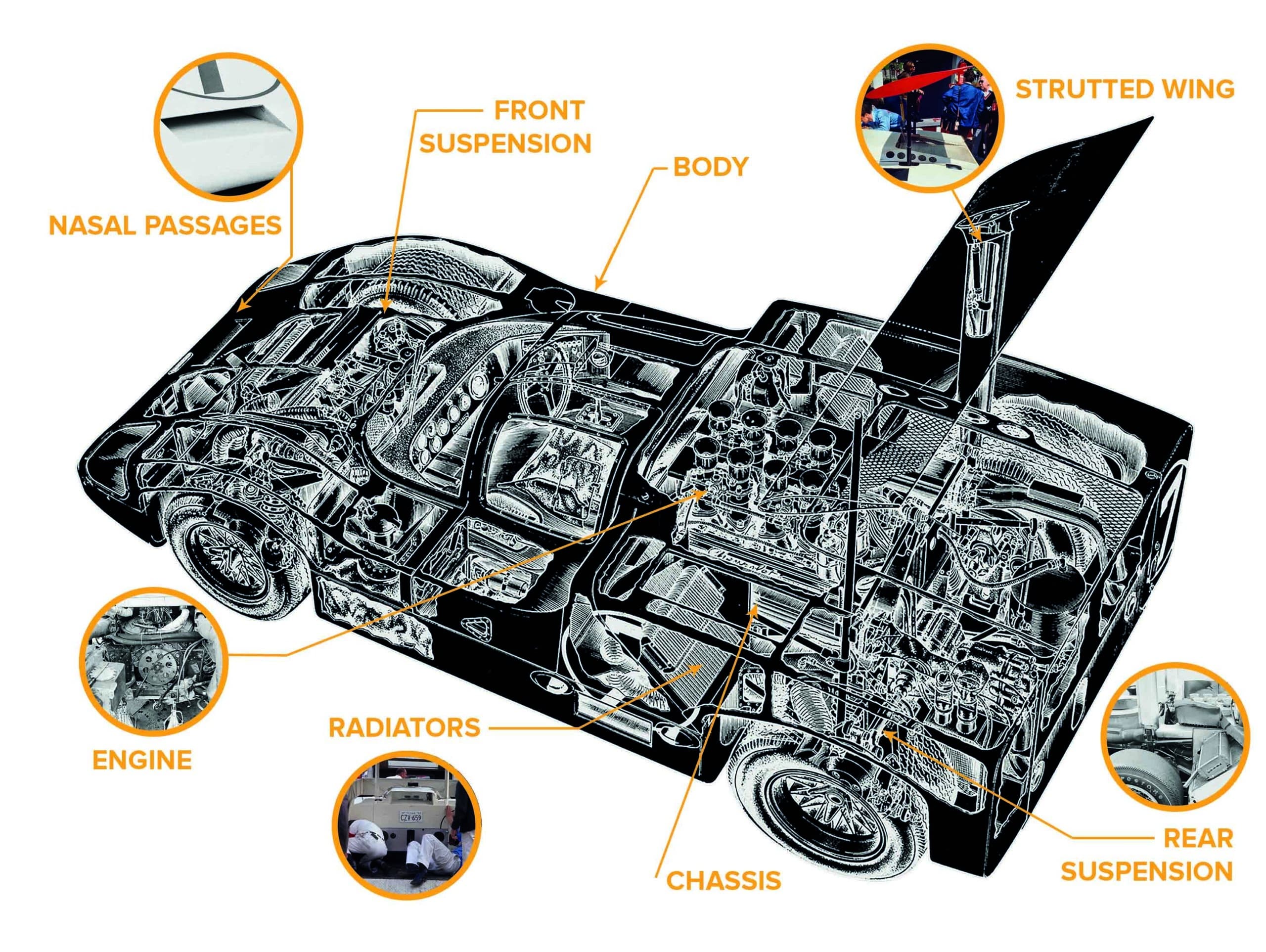
Nasal passages
Top air exit duct behind a nose-front air intake could be opened progressively against air pressure at speeds over 120mph. Engine cooling provided by split twin hip radiators to free nose for this aerodynamic device
Front suspension
Upper and lower wishbones, co-axial coil-spring/dampers, solid brake discs, Chaparral cast-alloy one-piece centre-lock 16in wheels
Body
Moulded glassfibre one-piece nose with pressure-relief louvres on front wings; one-piece glassfibre tail with separate radiator mouldings; expanded metal mesh panels at transom
Strutted wing
Two-position hydraulically- actuated rear wing bearing directly on rear suspension uprights. Here was DRS 44 years before F1-regulation DRS
Engine
Chevrolet 427 cubic inch/7-litre alloy big-block V8 engine, 4.25in x 3.75in bore x stroke, 4 Chevrolet- made Weber 58IDM carburettors, 525bhp, mated to Chevrolet 3-speed auto gearbox
Radiators
Hip-mounted each side, keeping mass within the wheelbase, reducing coolant volume in piping. Without a nose radiator cockpit is cooler; cold air can reach carburettors
Chassis
Moulded glassfibre monocoque chassis derived from earlier Chaparral 2A design and construction, with squared-off side pontoon extensions
Rear suspension
Anti-dive/anti-squat geometry, twin radius rods, reversed lower wishbones, single lateral top links, anti-roll bar

